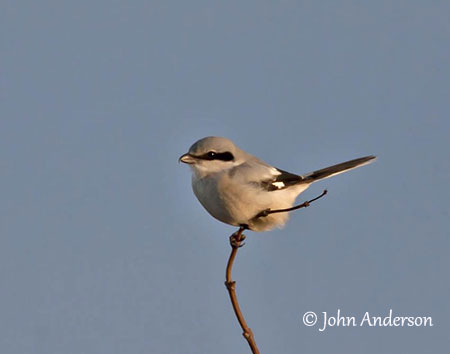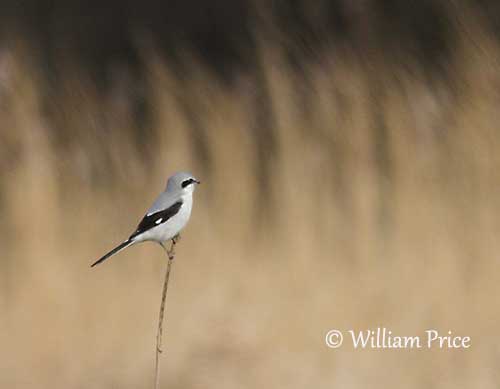
Fr: Pie-grièche grise
Ang: Great Grey Shrike
All: Raubwürger
Esp: Alcaudón Norteño
Ita: Averla maggiore
Nd: Klapekster
Sd: Varfågel
Photographers:
John Anderson
John Anderson Photo Galleries
William Price
PBase-tereksandpiper & Flickr William Price
Ingo Waschkies
Bird Photography
Text by Nicole Bouglouan
Sources:
HANDBOOK OF THE BIRDS OF THE WORLD Vol 13 by Josep del Hoyo-Andrew Elliot-Jordi Sargatal - Lynx Edicions – ISBN: 9788496553453
THE COMPLETE BOOK OF BRITISH BIRDS – Written by “Royal Society for the Protection of Birds” experts - Préface de Magnus Magnusson - Michael Cady- Rob Hume Editors - ISBN: 0749509112
THE HANDBOOK OF BIRD IDENTIFICATION FOR EUROPE AND THE WESTERN PALEARCTIC by Mark Beaman, Steve Madge - C. Helm - ISBN: 0713639601
ENCYCLOPEDIE DES OISEAUX DE FRANCE ET D’EUROPE – de Peter Hayman et Rob Hume - Flammarion – ISBN : 2082009920
FIELD GUIDE TO THE BIRDS OF NORTH AMERICA - National Geographic Society -ISBN: 0792274512
Animal Diversity Web (University of Michigan Museum of Zoology)
Birdwatch – The Home of Birding
Feeding habits of the Great Grey Shrike in winter
Feeding habits of Great Grey Shrike
Wikipedia, the free encyclopaedia
What Bird-The ultimate Bird Guide (Mitchell Waite)
The Guardian - Specieswatch: Great Grey Shrike
Great Grey Shrike
Lanius excubitor
Passeriformes Order – Laniidae Family
INTRODUCTION:
Like other Laniidae, the Great Grey Shrike has highly specialized feeding behaviour, unique among passerines. Its scientific name means “sentinel butcher”, referring to this behaviour.
It hunts by watching for prey from high, exposed perches. Once it is detected, the bird drops down on to it after a brief hovering. These prey, both large insects and small vertebrates, are killed with the strong, hooked bill. Then, the victim is impaled on thorns or barbed wire used as meat hooks. The Great Grey Shrike kills a large variety of prey, including small mammals and birds, various small vertebrates and invertebrates and large insects.
The Great Grey Shrike is not currently globally threatened throughout the wide range in Northern Hemisphere, in North America and Eurasia. Seven subspecies share this large territory.

DESCRIPTION OF THE BIRD:
Biometrics:
Length: 24-25 cm
Weight: 48-80 g
The Great Grey Shrike adult has pale grey upperparts with variable bluish wash, including top of head and nape to lower back. Rump and uppertail-coverts are pale grey too, but slightly paler. The upperwing is black with white bar across primary bases, and a smaller white patch at secondary bases. Flight feathers and tertials have white tips. The scapulars are white. The long, graduated tail is black with white outer rectrices.
The underparts are white, including chin and throat. The bird may have a weak pink tinge on breast in fresh plumage.
On the head, we can see a narrow black mask extending from bill base through lores and eyes to rear of ear-coverts. There is a very narrow, white supercilium, sometimes absent.
The strong, hooked bill is black. The eyes are dark brown. Legs and feet are blackish.
Male and female are similar, but males have more contrasting markings than females. The female may show a weak barring on the breast. She is usually slightly duller.
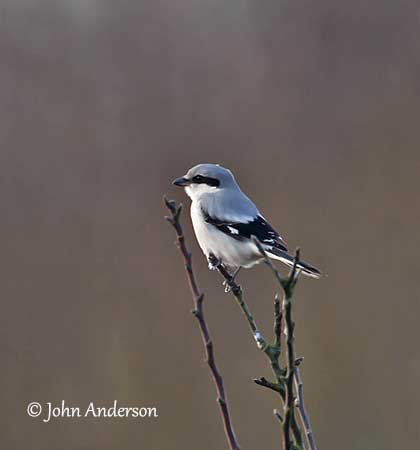
The juvenile is usually browner than adults, with indistinct vermiculations on upperparts and underparts. In autumn, it resembles adult female, but it retains some weak barring on breast and flanks, and pale-edged greater coverts.
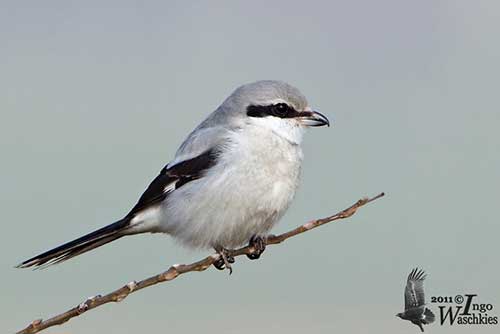
SUBSPECIES AND RANGE:
The Great Grey Shrike has seven subspecies that differ in plumage and body size.
L.e. borealis breeds in NE Canada. It is present in S Canada and most of W and C USA outside breeding season.
This race is similar to nominate with more conspicuous white supercilium, less white on upperwings and greyer underparts densely vermiculated dark. The juvenile is darker and browner than nominate.
L.e. excubitor (described above) breeds in N, C and NE Europe, E to NW Siberia. Present outside breeding season in S Scandinavia, Britain, W and S France, E to Asia Minor, Caucasus and Transcaspia.
L.e. sibiricus breeds in C and E Siberia, E to Kolyma Basin, Anadyrland and Chukotsk Peninsula, S to L Baikal, N Mongolia and SE Russia. It winters in SC Siberia, Mongolia, NE China and Ussuriland.
This race has ochre tinge above and some vermiculations below.
L.e. homeyeri breeds in SE Europe and SW Siberia. It winters in SW and C Asia.
This one is paler than nominate, with mostly whitish rump and uppertail-coverts. The supercilium is more conspicuous. There is more extent of white in wings and tail.
L.e. mollis breeds in CS Russia and NW Mongolia. Outside breeding season, it occurs in N China too.
This race is darker than “sibiricus” and has smaller white wing patch, buffer underparts with more vermiculations.
L.e. funereus occurs in E Kazakhstan and S Tien Shan.
This one is the largest. It is darker than “mollis” with more heavily vermiculated underparts.
L.e. bianchii breeds on Sakhalin Island and Kuril Islands. It winters in N Japan (Hokkaido).
This race is small, similar to “sibiricus” but paler and greyer, and less vermiculated below.
HABITAT:
The Great Grey Shrike frequents various types of open areas where it breeds, from semi-desert to farmland, heathland, scrub, bogs, and partly forested tundra and coastal dunes, all with scattered trees, scrub and bushes used as perches from which they hunt.
Outside breeding season, it can be found in similar habitats, but with more meadows.
CALLS AND SONGS : SOUNDS BY XENO-CANTO
The Great Grey Shrike gives a ringing “shreee” and a nasal “shack” as usual calls. The alarm call is a “trrr-tr-tr-trrr” or shorter “kwaa” or “aak”.
The song includes a collection of squeaks, trills and chattering phrases. During the courtship behaviour, both mates may perform duets.
BEHAVIOUR IN THE WILD:
The Great Grey Shrike feeds on large insects and small vertebrates including rodents and birds, lizards, frogs and invertebrates such as worms, snails, crustaceans and also spiders. It may consume small fruits and occasionally carrion.
It hunts from elevated perches such as top of bush or high tree branch, from which it drops down on to the prey. The victim is killed with the bill equipped with “tomial tooth” on each side of the upper mandible. Once the prey is killed, the shrike often impales it on thorns or barbed wires. It is sometimes torn into pieces before being eaten.
During the mating period, the prey are impaled at the edges of the territories and are well-visible. Most of the prey are left uneaten, indicating that this behaviour has a signaling function. When a female visits the territory, she can see that the chosen male is a good hunter able to feed her and the brood.
Outside this period, impaling is used to store food and the prey are regularly eaten.
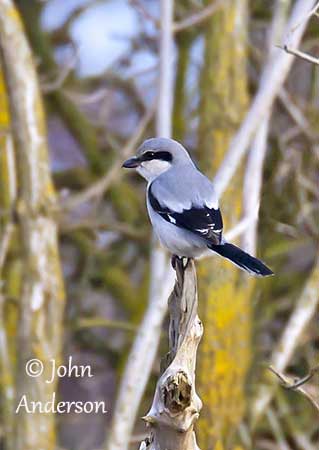
The Great Grey Shrike is monogamous during the season, but the pair-bond is lost over the winter. The male displays by singing and displaying the black-and-white wing and tail patterns. The female may join it and they display together while performing duets.
At this period, the impaled food items are in conspicuous places and the male feeds the female. It leads her to several nesting sites while calling, jerking the head and fanning the tail. The male initiates the copulation by bringing a prey to the female.
During the egg-laying, the male feeds its mate and guards her closely. This species usually produces a single brood per season, but a replacement clutch can be laid if the first one is destroyed. This species is highly territorial and the boundaries of the territories are usually established by vocalizations.
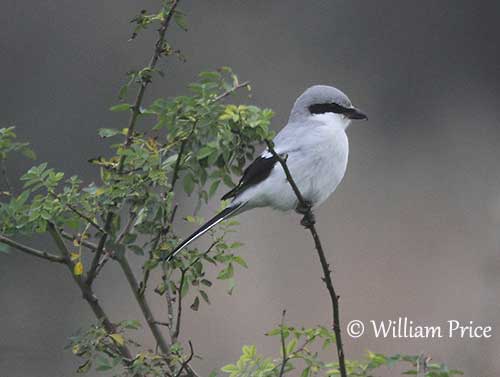
The Great Grey Shrike is migratory or partially migratory. In Europe, they leave the breeding grounds during September/October, and return in March/April. Some populations of SW Europe are largely sedentary compared the eastern ones.
In North America, they move S to California, New Mexico, N Texas and in E, S to N Carolina.
In flight, the Great Grey Shrike performs several rapid wingbeats interspersed with short glides.
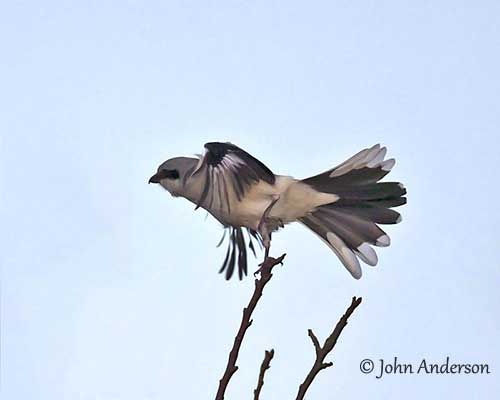
REPRODUCTION OF THIS SPECIES:
The breeding season occurs in spring with the laying between March and May according to the range.
Both adults build the nest, a large, bulky cup made with twigs and roots, grass and green plants. The cup is lined with rootlets, feathers and hair. It is placed in tree fork or on lateral branch, up to 15 metres above the ground, sometimes lower in dense bush.
The female lays 6-7 pale bluish-green eggs with brown spots. The incubation lasts 15-17 days, mainly by female fed by the male. At hatching, the chicks are brooded by the female and fed by the male. Some days later, both parents hunt and feed the young. They fledge 15-19 days after hatching. They remain with their parents during three weeks or more, and leave the natal territory between 4 and 7 weeks after fledging.
PROTECTION / THREATS / STATUS:
The Great Grey Shrike has a wide range in which it is common to uncommon. The trend is suspected to be decreasing in Europe, and probably elsewhere. This species is threatened by intensive agricultural management throughout the range.
The global population is estimated to number 3,130,000/24,000,000 individuals, but further validation is needed.
The Great Grey Shrike is currently evaluated as Least Concern.
